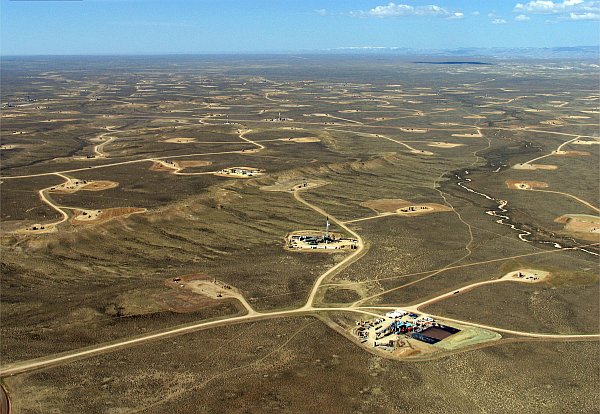
22 October 2011
First the game birds declined. Now the songbirds have, too.
A study led by Anna Chalfoun of the Cooperative Fish and Wildlife Research Unit at University of Wyoming has shown that the oil and gas boom in southwestern Wyoming has altered the landscape so much that plants, animals and songbirds have declined where sagebrush once ruled.
In 1998 the Bureau of Land Management opened the Jonah gas field to intensive natural gas development. The result is that the Upper Green River Valley changed dramatically from a sagebrush wilderness to a fragmented evenly-spaced industrial zone.
Those who love Wyoming saw an immediate change in the land and wildlife and petitioned BLM to revise their well-spacing rules. In 2003 Skytruth collected satellite images and aerial photographs illustrating the oil and gas footprint and testified to the Committee on Resources of the U.S. House of Representatives, again petitioning for a change in well drilling techniques.
Skytruth’s famous 2006 aerial photo of the Jonah gas field (taken by EcoFlight’s Bruce Gordon) is shown above.
Alas, policies didn’t improve and the Upper Green River Valley has become a living experiment in intensive natural gas development. What happens to the land, air, water and wildlife in the presence of this industrial activity?
According to Chalfoun’s study, some birds appear to be unaffected but Brewer’s, sage and vesper sparrows declined in direct proportion to the amount of wells, roads and human activity. This is especially significant because BLM classes Brewer’s sparrows and sage sparrows as sensitive species.
Pennsylvania is conducting its own living experiment in the Marcellus shale. What happens to our forests during Marcellus industrial activity?
Listen to this report from The Allegheny Front, The Gas Boom Comes to the Forest, to find out what Pennsylvania scientists have learned so far.
(photo of Wyoming’s Jonah gas field, May 2006, by Bruce Gordon of EcoFlight for Skytruth)
What is sad is that there are probably people who live in PA that would not care if parts of the state looked like this. : /
Kate – thanks for using Bruce Gordon’s stunning photo of gas drilling and fracking on public lands in western Wyoming. You can see many more aerial shots of this and other environmental issues on EcoFlight’s website – http://ecoflight.info/
Folks can browse SkyTruth’s galleries of satellite images at http://www.flickr.com/photos/skytruth/collections/ , including our Upper Green River Valley images at http://www.flickr.com/photos/skytruth/sets/72157625949361693/detail/
Truly a stunning photo! You have to ask yourself though, why is this being done? If you get down to the real root cause, it’s simply human overpopulation. Our insatiable demand for oil and gas is driven by an unabated expansion in the earth’s population. More people, more need for energy. Unless you start doing something about overpopulation, this type of environmental destruction will just continue until there’s nothing left.